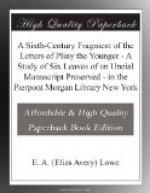Our examination of the Morgan fragment, therefore, leads to what I deem a highly probable conclusion. We could perhaps hope for absolute proof in a matter of this kind only if another page of the same manuscript should appear, bearing a note in the hand of Aldus Manutius to the effect that he had used the codex for his edition of 1508. Failing that, we can at least point out that all the data accessible comport with the hypothesis that the Morgan fragment was a part of this very codex. We have set our hypothesis running a lengthy gauntlet of facts, and none has tripped it yet. We have also seen that _{Pi}_ is most intimately connected with manuscripts BF of Class I, and indeed seems to be a part of the very manuscript whence they are descended. Finally, a careful comparison of Aldus’s text with _{Pi}_ shows him, for this much of the Letters at least, to be a scrupulous and conscientious editor. His method is to follow _{Pi}_ throughout, save when, confronted by its obvious blunders, he has recourse to the editions of his day.
[Sidenote: The latest criticism of Aldus]
Since the publication of Otto’s article in 1886,[68] in which the author defended the F branch against that of MV, to which, as the elder representative of the tradition, Keil had not unnaturally deferred, critical procedure has gradually shifted its centre. The reappearance of B greatly helped, as it corroborates the testimony of F. B and F head the list of the manuscripts used by Kukula in his edition of 1912,[69] and B and F with Aldus’s Parisinus make up Class I, not Class II, in Merrill’s grouping of the manuscripts. Obviously, the value of Class I mounts higher still now that we have evidence in the Morgan fragment of its existence in the early sixth century. This fact helps us to decide the question of glosses in our text. We are more than ever disposed to attribute not to BF but to what has now become the younger branch of the tradition, Class II, the tendency to interpolate explanatory glosses. The changed attitude towards the BF branch has naturally resulted in a gradual transformation of the text. We have seen in the portion included in _{Pi}_ that of the eleven readings which Keil regarded as errors of the F branch, three are accepted by Kukula and five by Merrill.[70]
[Footnote 68: “Die Ueberlieferung
der Briefe des juengeren Plinius,”
in Hermes XXI (1886), pp. 287 ff.]
[Footnote 69: See p. iv.]
[Footnote 70: See above, pp. 47 f.]
Since Class I has thus appreciated in value, we should expect that Aldus’s stock would also take an upward turn. In Aldus’s lifetime, curiously, he was criticized for excessive conservatism. His rival Catanaeus finds his chief quality supina ignorantia and adds:[71]
“Verum enim uero non satis est recuperare venerandae vetustatis exemplaria, nisi etiam simul adsit acre emendatoris iudicium: quoniam et veteres librarii in voluminibus describendis saepissime falsi sunt, et Plinius ipse scripta sua se viuo deprauari in quadam epistola demonstrauerit.”
[Footnote 71: See the prefatory letter in his edition of 1518.]




